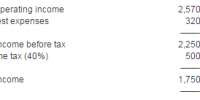Fixed assets to equity ratio measures the contribution of stockholders as well as the contribution of debt sources within the fixed assets with the company. It is calculated by dividing this fixed assets by the stockholders’ equity.
Other names with this ratio are preset assets to net worth ratio as well as fixed assets for to proprietors fund percentage.
Formula:
Fixed assets to stockholders’ equity ratio = Fixed assets / Stockholders’ equity
The numerator inside above formula is the book value of fixed assets (fixed possessions less depreciation) along with the denominator is this stockholders equity that contains common stock, recommended stock, paid throughout capital and kept earnings. Information about set assets and stockholders equity can be acquired from balance sheet.
Example
The finance manager of Heaven Earth company, wants to evaluate the long term solvency position of the company. He has extracted the following data from the financial statements of the company:
Fixed assets $ 1,290,000
Accumulated depreciation 90,000
Total of stockholders’ equity section 1,500,000
Required: Compute fixed assets to stockholders equity ratio as a part of the long term solvency test of Heaven Earth Company.
Solution:
Fixed assets to stockholders’ equity ratio = Fixed assets / Stockholders’ equity
= $1,200,000 / $1,500,000 = 0.8
or, 80% if expressed in percentage.
1,290,000 – 90,000 = 1,200,000
The ratio is less than 1. It means that all fixed assets and a portion of working capital of Bright Future Inc., is being financed by the stockholders’ equity.
Significance and interpretation:
In fixed assets to help stockholders equity ratio is more than 1, it means that stockholders equity is less than the fixed assets plus the company is applying debts to finance a portion of fixed assets. If the ratio is less than 1, it means that stockholders equity is a lot more than the fixed assets plus the stockholders’ equity is financing besides the fixed assets but also a component of the working capital.













